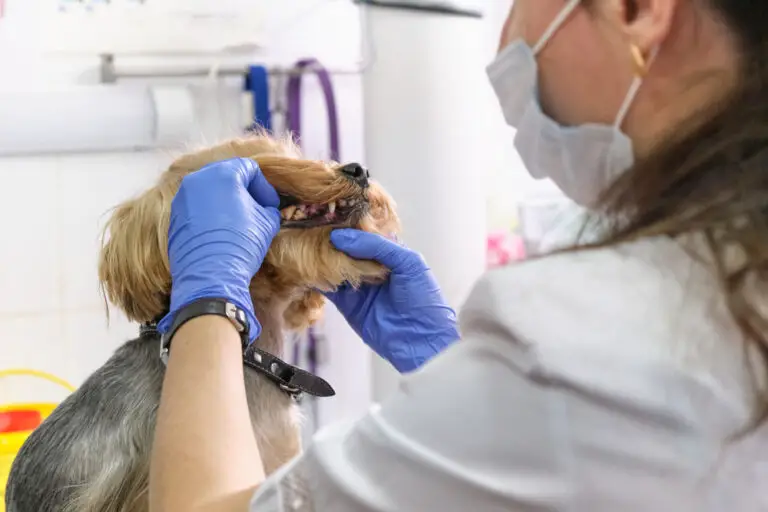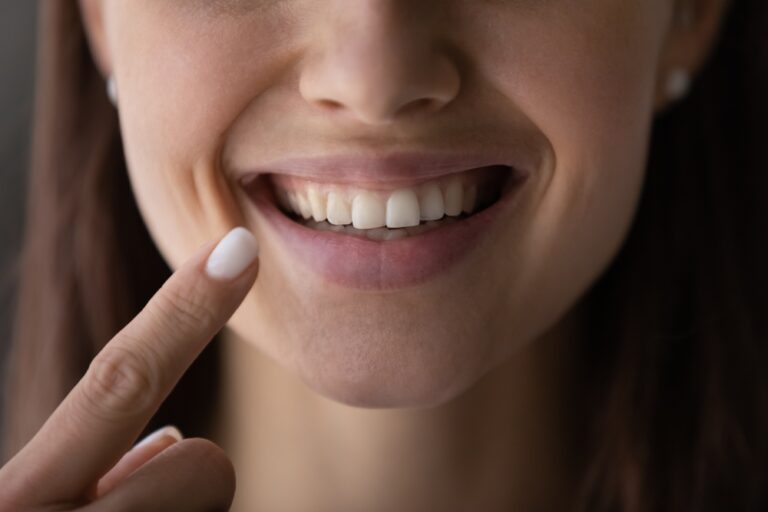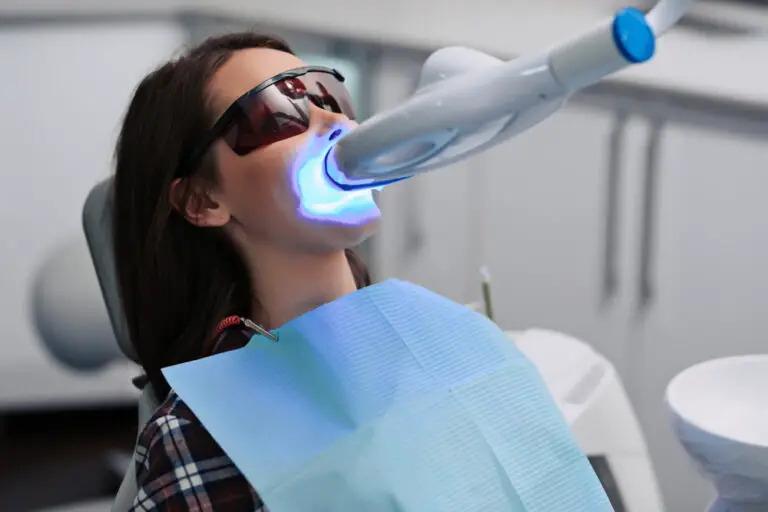Having straight, white teeth is now considered the ideal for attractiveness and health. However, research shows that our prehistoric ancestors actually had better alignment and fewer dental problems than we do today. Archaeological evidence indicates hunter-gatherers had very little tooth decay or crowding. So why do modern humans have such high rates of crooked, crowded teeth when our ancestors had mostly straight teeth? There are several leading theories that attempt to explain this phenomenon.
Why do we have crooked teeth when our ancestors didn’t?
1. Diet Changes Over Time
One of the main reasons researchers propose for our crooked teeth relates to diet changes over time. Our early hunter-gatherer human ancestors consumed much tougher and harder foods that required extensive chewing and tearing. Their diet consisted of coarse grains, fibrous vegetables, hard nuts, tough meats, and crunchy fruits. This natural fare acted as a primitive dental floss, wearing down the occlusal surfaces of the teeth properly so they fit well within the jaw. The vigorous chewing patterns also massaged the gums and stimulated increased saliva production.
In contrast, today’s soft, highly processed foods do not clean teeth or exercise jaw muscles nearly as much. The modern diet high in refined flour, sugars, dairy, and processed convenience foods tends to get stuck in and around teeth. This allows oral bacteria to thrive and produce acids that cause tooth decay and enamel erosion. The lack of chewing from a young age also allows jaws to grow improperly, leaving inadequate room for all the teeth. This is why dental crowding is extremely rare in indigenous cultures that maintain traditional diets even today. Their coarse diets provide the environmental pressures that help guide proper dental development.
2. Transition from Hunter-Gatherer to Farming Lifestyle
The gradual transition from a hunter-gatherer lifestyle to one based on agriculture and farming also had significant impacts on diet, dental wear, and ultimately tooth alignment. While the first naturally straight teeth evolved with our genus Homo around 2.5 million years ago, dental problems seem to have appeared with the agricultural revolution beginning roughly 10,000-12,000 years ago. Early agricultural diets consisted mainly of porridge, gruel, mush and eventually bread. This extremely soft food was processed through boiling and grinding, dramatically reducing the need for chewing and tearing.
This lack of abrasion did not wear down the occlusal surfaces of the teeth adequately, nor did it stimulate ideal jaw development and growth. Dental crowding, cavities, periodontal disease, and malocclusion (improper bite alignment) began to become much more prevalent with the agricultural shift. This set the stage for the high rates of crooked teeth observed today.
There were several other subtle shifts that occurred with the agricultural transition that likely exacerbated dental problems as well:
- Increased reliance on just one or a few staple crops reduced nutrition variety and density compared to the hunter-gatherer diet. This negatively affected dental and oral health.
- Higher consumption of grains and cereals increased cavities from carbohydrates.
- Millet consumption in some regions intensified abrasion and wear of teeth.
- Agricultural lifestyles tended to be more sedentary with the development of villages and towns. This decreased mastication from a lack of foraging activity.
Overall, the agricultural lifestyle transformation seemingly decreased the muscular demands on the jaw, face, and teeth. This reduced proper development and alignment.
3. Rise of Industrial Food Processing

The Industrial Revolution brought about more significant changes, including increased availability and consumption of refined sugars, white flour, and highly processed convenience foods. The quantity of sticky carbohydrates that adhere to tooth surfaces surged. This provided even more fuel for the bacteria responsible for tooth decay and erosion. The lack of fiber, vitamins, and minerals from whole foods was another consequence of processed foods with negative impacts for oral health. Jaw development problems and crowded teeth became even more common with these dietary shifts.
Today’s incredibly soft, refined, processed foods do not properly wear down our teeth at all. Our jaw muscles get little exercise compared to our ancestors. This has dramatically changed the overall structure and development of modern jaws and teeth for the worse. Crowded, crooked teeth requiring orthodontics are much more prevalent now as a result of our highly processed, fiber-free modern diets.
4. Declining Duration of Breastfeeding
Another significant shift that researchers point to is the declining duration of breastfeeding over time. Breastfeeding plays an integral role in babies’ oral development and strength. The motions a baby’s tongue makes when nursing act as a natural orthodontic appliance. This stimulates ideal development of the jaw muscles and bones and guides proper tooth alignment. The longer babies are able to breastfeed, the more this beneficial stimulation occurs.
Today, mothers tend to breastfeed their babies for much shorter durations on average compared to our ancestors. For example, the WHO and AAP now recommend breastfeeding for just the first 6 months of life. However, the natural biological norm for humans is 2-3 years of breastfeeding, as was practiced for millennia. As breastfeeding duration declined over history, crowded and crooked teeth tended to become more common.
5. Genetic Drift
A number of genetic factors may also play a role in our modern misaligned teeth:
- As cooking methods became prevalent, this softened food and reduced the need for lengthy chewing. Over time, human jaws have gotten smaller through evolutionary genetic drift. Less room means teeth have become more crowded.
- Some specific genetic mutations have been linked by research to various types of dental malocclusions, or misalignments of the teeth and bite.
- Certain hereditary conditions like cleft lip and cleft palate strongly predispose patients to severely crooked teeth due to oral bone and tissue abnormalities.
Additionally, modern humans have significantly smaller jaws than even our closest ape relatives. This indicates evolutionary shifts in our genes are at least partly responsible for our dental woes. Epigenetic factors may also be involved, whereby lifestyle factors influence how genes are expressed over generations.
6. Other Modern Factors

Beyond diet and genetics, a few other modern factors also likely contribute to problems with teeth alignment and crowding today:
- Orthodontic interventions can sometimes accidentally worsen tooth alignment in the long run. Certain extractions and appliances permanently alter natural growth.
- Chronic mouth breathing promotes crooked teeth by not holding the tongue against the palate properly during rest and swallowing. This disrupts the forces guiding eruption.
- Prolonged thumb sucking as a child may influence poor tooth positioning.
- Some studies have found a correlation between bottle feeding infants and increased need for orthodontic treatment later on.
While genes likely play some role in modern crowded teeth, it also seems clear that many modifiable lifestyle choices affect proper jaw development and tooth alignment. Maintaining a tough, primitive diet when young and utilizing proper oral posture may encourage naturally straight teeth. These habits can potentially override one’s genetic tendencies.
Comparison of Diets Over Time
| Dietary Factor | Hunter-Gatherers | Early Agriculturalists | Modern Society |
|---|---|---|---|
| Hard, Tough Foods | Very Common | Declining | Rare |
| Unprocessed Plant Foods | Abundant | Declining | Scarce |
| Refined Sugars | None | Increasing | Very High |
| Soft, Processed Foods | None | Increasing | Very Common |
| Breastfeeding Duration | 2-3 Years | Declining | 3-6 Months |
Consequences of Crooked Teeth
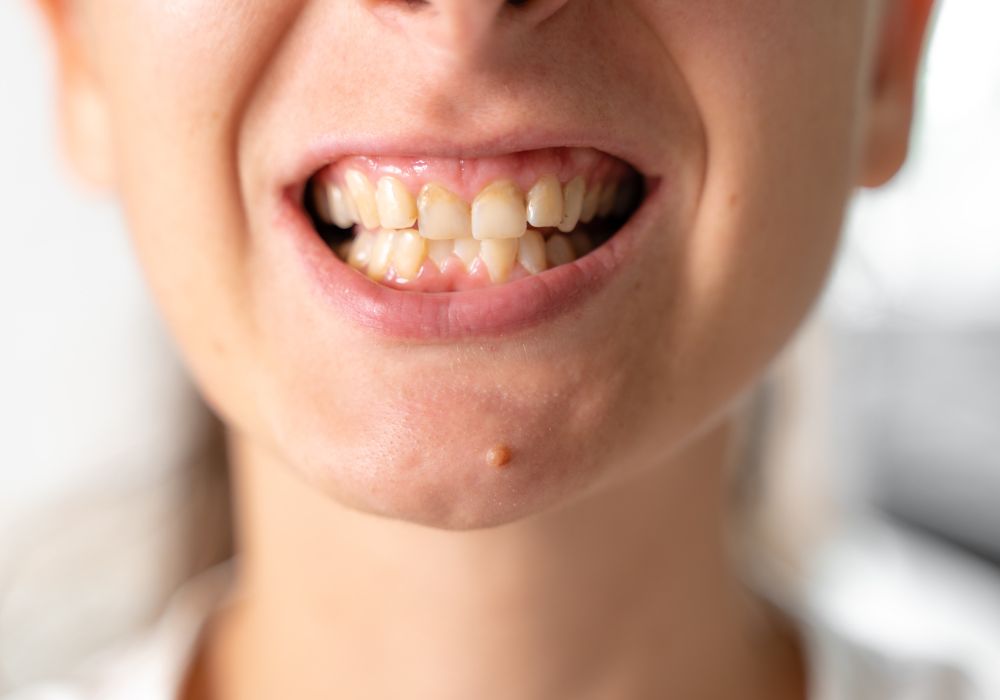
Having crooked and crowded teeth is not just an aesthetic problem. Misaligned teeth lead to a number of oral health complications:
- Tooth decay – Crooked teeth with crowding are much harder to clean properly. Food and bacteria gets trapped between teeth and in Areas that tools can’t reach. This dramatically increases cavities and enamel decalcification.
- Periodontal disease – Similarly, misaligned teeth allow plaque to accumulate in ways that promote inflammation and bacterial infection of the gums. This destroys the tissues and bone supporting teeth.
- Abnormal wear – Crooked teeth are also prone to grinding against each other in abnormal ways. This can accelerate wearing down of the enamel and damage.
- Speech difficulties – Malocclusions make proper pronunciation of certain sounds challenging. Children may need speech therapy with certain bite issues.
- Chewing problems – Crooked teeth interfere with normal chewing motions and ability.
- TMJ disorders – Jaw pain, popping, and musculoskeletal dysfunction often result from an uneven bite and misaligned jaws.
Because of these extensive problems that result from crowded, crooked teeth, correcting malocclusions and properly aligning teeth is extremely important for oral health and function. Straight teeth are easier to clean as well.
Orthodontic Treatments
Modern orthodontics aims to bring teeth, jaws, and bite back into proper alignment and a functional state. Some of the most common orthodontic interventions include:
- Braces – Brackets are bonded to each tooth and connected with an archwire that applies light pressure to slowly shift position over time.
- Clear aligners – A series of customized, transparent, removable plastic aligners are worn in sequence to gradually move teeth.
- Headgear or facemask – Appliances with head straps provide anchorage and orthopedic forces to guide jaw growth.
- Palatal expanders – Devices are fixed to the palate to mechanically widen the upper jaw in order to create more space for crowded teeth.
- Retainers – Removable plastic appliances are worn after treatment to hold teeth in their new corrected positions.
While modern orthodontic treatment offers great benefits, there are some risks to consider as well. Enamel decalcification, gum disease, tooth root resorption, and relapse after appliances are removed remain concerns. Proper oral hygiene and compliance with retainers are critical to maintain improvements from orthodontics.
Preventing Crooked Teeth
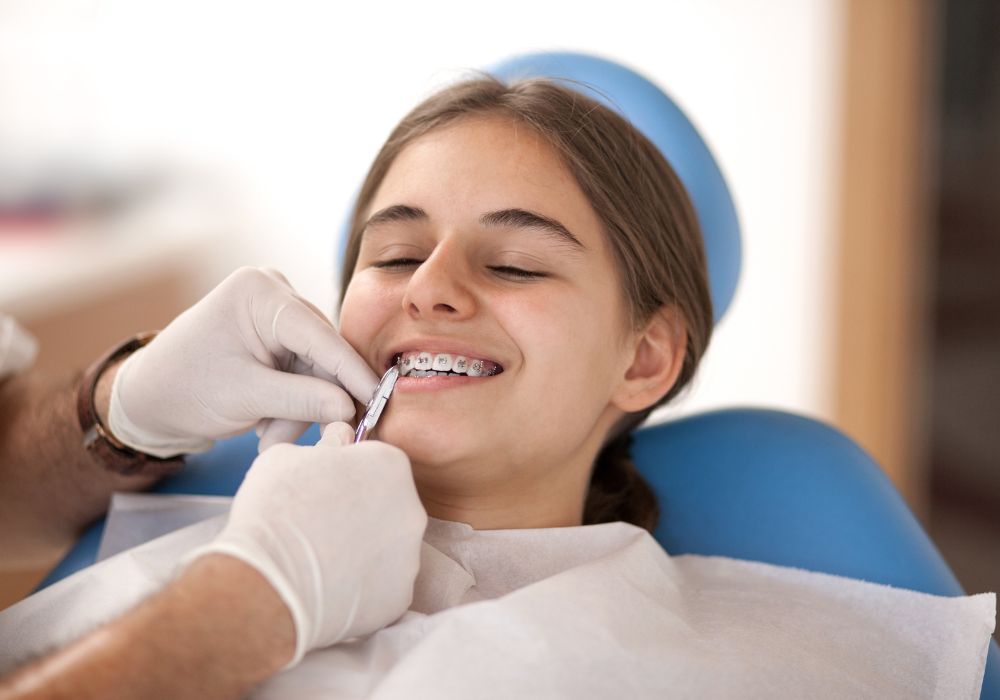
Certain practices during early childhood may encourage normal dental development and prevent crooked teeth:
- Eat a diet of tough, crunchy whole foods – fruits, raw vegetables, nuts, seeds, meats. Avoid processed carbs.
- Limit refined sugars and flours that alter oral flora.
- Breastfeed for at least 1-2 years or longer to strengthen jaws.
- Stimulate chewing muscles regularly with mastic gum, tough meats, etc.
- Maintain proper tongue posture against the palate while resting and swallowing.
- Avoid prolonged thumb sucking and bottle feeding with milk or juice.
- Visit a dentist regularly to catch any problems early before they worsen.
With diligence to these habits when young and early orthodontic correction if needed, straighter, properly aligned teeth are certainly achievable. While modern diets make it challenging to replicate ancestral alignment, getting teeth at least closer to this ideal is within reach.
Conclusion
In summary, prehistoric hunter-gatherers had uniformly straight teeth, minimal decay, and well-developed jaws. This changed with the agricultural revolution and increasingly softer foods. Refined, processed foods in modern times accelerated tooth misalignment. Declining breastfeeding duration and genetic shifts also contribute. Crooked teeth lead to serious health issues beyond just aesthetics. Corrective orthodontics is often essential. While genes play a role, many lifestyle choices when young can mitigate crooked teeth despite the challenges of our modern age. With some diligence, teeth that resemble our ancestors’ are still possible.
Frequently Asked Questions
Why did hunter gatherers have straighter teeth?
Hunter-gatherers typically had uniformly straight teeth because their extremely coarse, fibrous diet of meats, vegetables, nuts and seeds wore down the chewing surfaces naturally. This created proper spacing and ideal alignment. The tough foods also stimulated very strong jaw and facial muscle development that supported this alignment.
How did agriculture change teeth?
The transition to agricultural softened foods like porridge, gruel, bread and mush reduced chewing and abrasion. This allowed teeth to crowd and malocclude. Nutrition declines and increased carbs also led to much more cavities and gum disease. Teeth became crooked and unhealthy.
Do indigenous tribes today have straight teeth?
Yes, indigenous tribes worldwide that maintain traditional whole food diets incorporating tough plant foods and meats tend to have uniformly straight, healthy teeth even today. For example, the Amazonian Guarani tribe has almost no tooth decay or crowding due to their plant-based diet.
Can you straighten teeth without braces?
It is extremely challenging to significantly straighten moderately or severely crooked teeth in adults without orthodontic treatment. However, chewing tough foods, proper tongue posture, and facial muscle exercises may help slightly. Clear plastic aligners are also far less visible orthodontic options. Prevention when young is ideal.
What problems do crooked teeth cause?
Crooked teeth are prone to severe cavities, gum disease, abnormal wear, TMJ disorders, speech impediments, and chewing issues. Bacteria and food readily get stuck in hard-to-clean areas. Misalignments also impact bite and jaw function. Straightening the teeth helps prevent these myriad problems.

